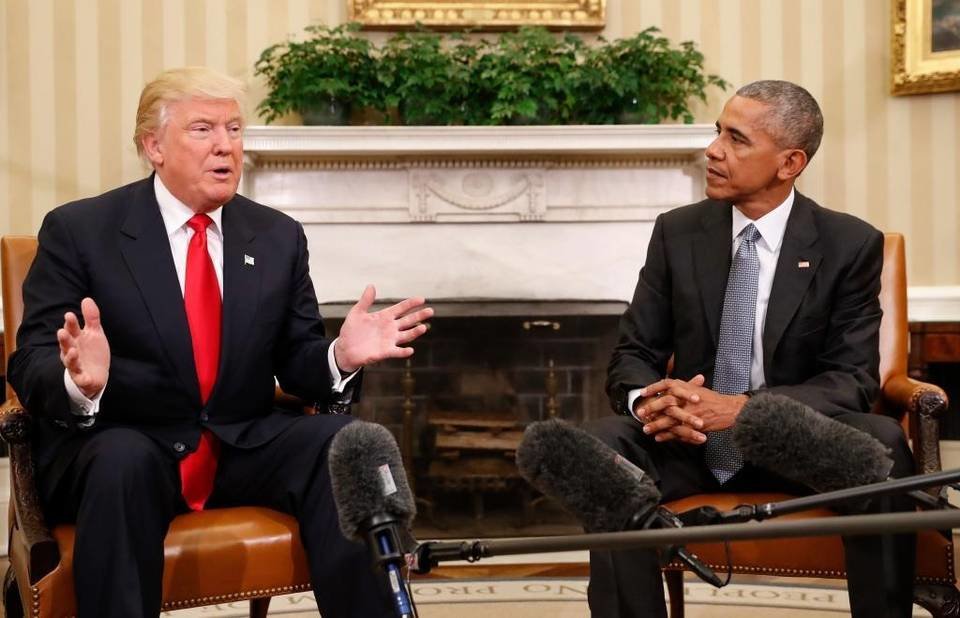Trump will be able to change some of Obama's policies with a quick stroke of the pen. Others will be much more difficult, requiring justification to pass legal hurdles or buy-in from lawmakers on Capitol Hill or foreign leaders.
"He can make a big difference at the outset of his administration, but it will take him years and support from dubious congressional factions and allies overseas to get a lot of other things done," said Charles Tiefer, former solicitor and deputy general counsel of the House of Representatives and now a professor at the University of Baltimore law school.
Despite the strong rhetoric on the campaign trail, Obama and Trump were complimentary of each other after meeting for 90 minutes — longer than expected — seated alone in the Oval Office Thursday.
"I have been very encouraged by the, I think, interest in President-elect Trump's wanting to work with my team around many of the issues that this great country faces," Obama told reporters after the meeting.
It was the first time the two had met. Obama described the conversation as "excellent," while Trump called Obama "a very good man."
"I very much look forward to dealing with the president in the future, including counsel," Trump said. "So, Mr. President, it was a great honor being with you, and I look forward to being with you many, many more times in the future."
It was only days ago that Obama had described Trump as a threat to the republic, blasting his temperament and policies. Long before the presidential race launched, Trump had spent years questioning whether Obama had been born in the United States and was able to serve as president.
"The two men did not relitigate their differences in the Oval Office," White House Press Secretary Josh Earnest said. "We're on to the next phase."
On Thursday, the two men put aside their differences, as least publicly. Obama Chief of Staff Denis McDonough showed Trump's top adviser and son-in-law, Jared Kushner, around the White House. First lady Michelle Obama met with Trump's wife, Melania Trump, while Vice President Joe Biden met with Vice President-elect Mike Pence.
Later in the day, Trump emerged from meetings with House Speaker Paul Ryan, R-Wis., and Senate Majority Leader Mitch McConnell, R-Ky., and noted that he wants to work on health care, immigration, lower taxes and job creation - all moving in an opposite direction from Obama.
In one important way, Obama made it easier for Trump to undo some of his accomplishments.
William Galston, a former White House adviser to Bill Clinton who's now a senior fellow at the center-left Brookings Institution, noted that Obama relied on a slew of executive actions to get things done after his Democratic Party lost control of Congress.
"One of the consequences of the last six years has been an increasingly expansive use of executive power," Galston said.
Trump's presidency puts many of Obama's achievements in jeopardy.
He's pledged to repeal the Affordable Care Act, pull out of the Iran nuclear deal, resume deporting immigrants who are in the U.S. illegally, kill policies designed to help ease climate change as well as the Trans-Pacific Partnership - a pending trade pact involving 12 Pacific Rim nations - and remove Obama's executive actions.
Comment: Trump may keep certain aspect of the Affordable Care Act in place.
Trump's remarks about the Affordable Care Act also raised some eyebrows Friday. He told The Wall Street Journal in an interview that, after speaking with Obama at the White House the day before, he was considering keeping the clause that allows children to stay on their parents' insurance policies. In a separate interview with CBS' "60 Minutes," he said "it happens to be one of the strongest assets."
He has previously said he may keep the prohibition against insurers denying coverage because of patients' existing conditions.
Trump will be able to rescind Obama's executive orders immediately if he wants.
Examples include those that bar companies that do work for the federal government from discriminating against employees on the basis of sexual orientation and those that halted the deportation of some immigrant children who are here illegally.
"Almost everything a president does by executive order can be undone by a subsequent executive order," said Ken Mayer, a political science professor at the University of Wisconsin-Madison who wrote "With the Stroke of a Pen: Executive Orders and Presidential Power."
Obama himself signed an executive order as soon as he came into office reversing a ban on funding to international family planning groups that provide abortions. It was implemented by Ronald Reagan, rescinded by Bill Clinton and restored by George W. Bush.
"You may 'win' or 'lose' every four to eight years, depending on whether the president shares your policy preferences, but at some point you have to wonder: Is this any way to govern a country?" asked Gene Healy, a vice president of the libertarian Cato Institute who's the author of "The Cult of the Presidency: America's Dangerous Devotion to Executive Power."
Others Trump priorities may fall under the Administrative Procedure Act, which requires "sufficient rational justification" before changes are made. A Reagan-era court case mandated that regulation changes aren't done on a whim. "He has to dots his 'i's and cross his 't's," Tiefer said.
Some would take congressional action, including repealing the Affordable Care Act, building a wall on the U.S.-Mexico border and levying tariffs on companies that move operations overseas.
Others that also would be more difficult involve the actions of other countries, such as renegotiating the North American Free Trade Agreement, as well as the Iran nuclear deal.
Eight years ago, Obama learned quickly how hard some priorities are to implement. He immediately issued an executive order closing the prison for suspected terrorists at Guantanamo Bay in Cuba. Eights years later, the facility remains open with some lawmakers of both parties opposed to the closure.




Reader Comments